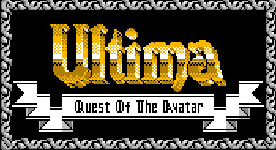
 |
|
Origin's Ultima series was a huge hit with PC gamers. Console gamers got to see what they'd been missing with the release of Ultima III: Exodus for the NES, and they got even more in Ultima IV: Quest of the Avatar. This game was unique from the opening "personality test" style character creation process, through exploring the last dungeon. And imagine this -- an RPG in which there's no powerful enemy to vanquish... except for yourself.
The goal of Quest of the Avatar seems to be simple enough at first glance -- as the hero, you must free the people of Brittania from the evil within their hearts by mastering the eight virtues and becoming the Avatar, an example of goodness that they can follow. Each of the virtues corresponds to a town in Britannia, and to a character class. Your own character's class is chosen through a system in which you're asked a series of "what if" questions that determine which virtue you possess most. (That can at times be ego-boosting - who doesn't like to be told they're strong in Valor or Honor?) By travelling by foot or by moongate to each of the other seven towns, you find warriors embodying the other seven virtues, whom you can enlist to aid your quest. Mastering the virtues is done in rather creative ways. By giving coins to beggars you advance in Compassion, and by giving blood at the Healer you advance in Sacrifice (an odd concept to find in a video game). But on the other hand, taking a treasure chest from someone's house makes you lose the virtue of Honesty, and replying boastfully to a question makes you lose the virtue of Humility. This is one game in which you can't afford to give smart-alecky answers to random NPCs -- it could set you back hours of work!
Once you manage to master the virtues, your next task is to be granted Avatarhood in them by visiting the shrine of each. Of course, you can only gain entry if you managed to find the runes of those virtues, which are scattered throughout the world. Finding some of them takes an awful lot of looking plus a little bit of luck, making your quest a little frustrating at times. Still, that means you're incredibly glad when you finally do find them.
Even though the strongest emphasis is on advancing your character's morality, the traditional aspects of RPGs are not forgotten. In fact, they're enhanced. The many maze-like dungeons are explored from a first-person perspective rather than the overhead view offered by most console RPGs, and well-designed -- you just have to make sure you have enough torches, or you'll be left fumbling around in the dark. Random enemy encounters are different from the turn-based battle systems of Final Fantasy and Dragon Warrior, in that the heroes are arranged on a battlefield and have to advance to engage the enemy (unless they happen to have a long range weapon or Missile spell handy). The magic system also differs from the norm in that each spell requires the use of a combination of herbs, which you can mostly buy in stores. There are a few you have to harvest yourself in the wild, and under rather specific circumstances. Those who have played the game will probably remember sitting in the swamp for ages, waiting until the moons were both dark for the Manroot to appear.
Another unique feature of the Ultima series is that the moons played a large part. Besides events which only take place at certain phases, the quickest way to get around is through the moongates that open and close as the moons wax and wane. The first moon's phase indicates where the gate will appear, and the second moon dictates where you'll come out. As a result, some places you can get to quite easily, while others require a few stops along the way. Of course, if you don't feel like waiting around, you can always beat up some pirates and take their ship. Or later on, you can stock up on the necessary herbs for the Wind spell and go by balloon. The drawbacks to the game are for the most part the same kinds of problems all RPGs face at some time or another -- random encounters become tedious when you're trying to get someplace fast, and then there are those pesky runes that can be hard to find -- but overall, Quest of the Avatar is an excellent game, different enough from other console RPGs to make it stand out from the rest. Retrospective by Andrea Hartmann. |
|
|||||||||||||||||||||||||||||||||||||||||||||




